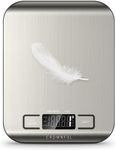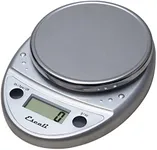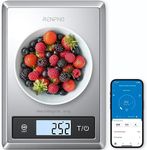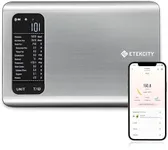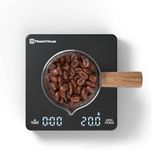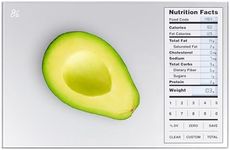Buying Guide for the Best Food Scales
Choosing the right food scale can make a big difference in your kitchen, whether you're cooking, baking, or tracking your nutrition. The best food scale for you depends on how you plan to use it, how much space you have, and what features matter most to you. Understanding the key specifications will help you find a scale that fits your needs and makes your food preparation easier and more accurate.CapacityCapacity refers to the maximum weight the scale can measure. This is important because it determines what kinds of foods or containers you can weigh. Scales with lower capacities (around 1-2 kg) are great for small portions, baking ingredients, or meal prep, while higher capacities (up to 5-10 kg) are better if you often weigh larger items or bulk foods. Think about the typical amount of food you need to weigh at once and choose a scale with a capacity that covers your usual needs, with a little extra room for flexibility.
Accuracy/PrecisionAccuracy or precision tells you how small a difference the scale can detect, usually shown in grams or ounces. This is crucial for tasks like baking, where exact measurements matter, or for tracking nutrition closely. Scales with 0.1-gram precision are best for very fine measurements, while 1-gram precision is enough for most home cooking. If you need to measure tiny amounts (like spices or supplements), go for higher precision; for general use, standard precision will do.
Units of MeasurementMost food scales can display weight in different units, such as grams, ounces, pounds, or milliliters. This feature is important if you use recipes from different countries or need to switch between metric and imperial systems. Make sure the scale you choose offers the units you use most often, and check that switching between them is easy and clear.
Tare FunctionThe tare function lets you reset the scale to zero after placing a container on it, so you only measure the food itself. This is essential for convenience and accuracy, especially if you often use bowls or plates. Almost all digital scales have this feature, but it's good to check that it's easy to use and works reliably.
DisplayThe display is where you read the weight. A clear, easy-to-read display is important, especially if you work in a dim kitchen or need to see numbers quickly. Look for a display with large digits and good backlighting. If you often use large bowls, consider whether the display might be blocked when weighing bigger items.
Platform Size and MaterialThe platform is the surface where you place your food or container. A larger platform is helpful for weighing bigger items, while a smaller one saves space. Materials like stainless steel are durable and easy to clean, while glass can look sleek but may be more fragile. Think about the types of items you weigh and your kitchen habits to decide what size and material will work best for you.
Power SourceFood scales can be powered by batteries, USB charging, or even manual winding. Battery-powered scales are common and portable, but you'll need to replace batteries occasionally. USB-rechargeable models are convenient if you want to avoid buying batteries. Consider how often you use the scale and whether you prefer the convenience of recharging or the simplicity of batteries.
Ease of CleaningSince food scales often come into contact with ingredients, it's important that they're easy to clean. Scales with smooth, sealed surfaces are easier to wipe down, while those with removable platforms can be washed more thoroughly. If you cook messy foods or want to keep things hygienic, look for a design that makes cleaning simple.
